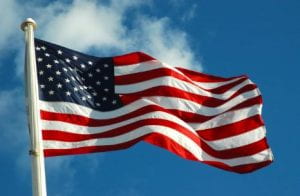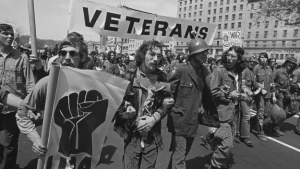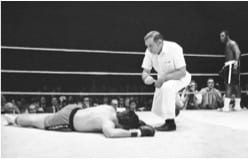By: Ashton Reynolds

Photo Courtesy of The Guardian.

Courtesy of AP Steven Senne
In The Politics of Collective Violence, historian and sociologist, Charles Tilly explains that the word riot is infused with political meaning. He states that the term riot “embodies a political judgment.” According to Tilly, when power-holders and those who are contingent to power-holders (i.e. those who are at the front of the line in receiving benefits from power-holders) disapprove of violence by those outside of their power structure, they label these demonstrations as riots.
Even when instances of violence are justified, those in power often describe the violence as riotous in order to delegitimize those outside of their group. Once power-holders employ this rhetoric, the assemblies in question are assessed as subhuman and destructive, which further solidifies the strength of those who control the inner-workings of social and political power.
A Historical Example of a Misrepresented Gathering: Millican, TX 1867-1868

In late summer of 1867, the town of Millican, Texas fell victim to a large outbreak of yellow fever that was raging through the state. George E. Brooks, the minister of a black Methodist Episcopal Church and registrar of voters for Brazos County, set aside politics, race, and grievances to treat sick and dying victims of yellow fever as the majority of the town attempted to distance themselves from those with the viral disease.
Brooks’ acts were a remarkable display of courage and humanity. He not only cared for black citizens of Millican; he took care of white citizens, the majority of whom undoubtedly detested the fact the he served as county registrar. Indeed, Brooks received some minimal appreciation for his indiscriminate care of the sick and dying. The gratitude of whites, however, only went so far. Just short of a year later, Brooks’ body was found decomposing in the hot sun on the banks of the Brazos River. His flesh had been removed in strips and his face disfigured beyond recognition. He was identified only because one of his remaining hands showed a missing finger from an earlier injury.
The Event that Led to the Eventual Murder of George Brooks
In the summer of 1868, race relations in Millican proved particularly strained. Blacks were shown definitively that their skin color nullified any possible reconciliation that Brooks’ actions as a caregiver may have initiated. In July, members of the Ku Klux Klan attempted to intimidate Brooks and his congregation by firing shots at them. To the shock and dismay of the KKK members, the congregants defended themselves by returning fire. The congregants’ response was so effective that the clansmen rode away quickly, and in their haste left their robes, masks, and pistols on the ground in front of the church meeting place.
The congregation did not rest on their laurels. Rev. Books organized and trained a black militia to defend the black community of Millican from future attacks. Whites knew of the militia because they trained every Saturday in full view of both black and white citizenry. As expected, the white citizens were unhappy about the black militia’s existence and even more dissatisfied with their practice of consistently drilling.
Most assuredly, the trouble that the militia prepared for came their way. What became known as the Millican Riot began with a rumor. A leader among the freed persons of Millican went missing, and it was said that he had been lynched because he sought to collect a debt owed to him by a white man. The truth was that the leader had simply gone to neighboring Washington County.
However, because Brooks was unsure about what happened to the man, he sent the captain of his militia with a detachment of men to find the body in order to confirm the lynching. While on their search, the militia came around a bend in the road. There, they came face to face with the mayor of Millican, as well as the deputy sheriff and a white posse who had come to ensure the militia did not take retribution against the supposed instigator of the lynching, i.e the white man who owed the debt to the missing freedman.
As is often the case when white Southerners described their conflicts with blacks at the time, the white posse claimed that violence began because blacks initiated it. The whites claimed that they were in the process of successfully brokering peace with Brooks’ captain until “a small negro” in the back discharged his weapon. They responded by firing upon the militia, which resulted in the killing of fifteen to twenty freedmen including the captain with whom they were supposedly brokering peace.

Undoubtedly, this is not what actually happened. Rather, it is the fantasy of whites from the past and the present to obscure the fact that the white posse had no intention of negotiating. Instead, more than likely, Brooks’ men were shot down before a word could even be spoken. And Brooks was subsequently murdered.
In the flurry of news reports that followed in the days following, whites sufficiently exercised rhetorical power ensuring that what was in fact a racist massacre designed to terrorize the black citizenry and punish black leaders was labeled a “riot.” From Galveston to New York, newspapers participated in the active delegitimization of Brooks, his militia, and the black citizens of Millican. Despite the inaccuracy of the published stories about this event, mainstream readers believed what they read, and they capitalized on the word “riot.”
The story of what truly happened in Millican was replaced with a sensationalized tale about the supposed irrational and undisciplined actions of blacks that threatened the safety of rational, law-abiding whites. As is often the case when describing the actions taken by non-white actors against whites in power, “riot” was the name that was used at the time of the event and subsequently canonized by the historical record. To this day, the event is most often referred to as the “Millican Riot” rather than the “Millican Massacre,” the preferred term of historians who have studied the event.
Connections to the Present
Of course, the politicization of the word riot is not restrained to that particular subset of American society. To this very day, the ethics that we citizens of the United States profess and those that we practice are in sharp contrast and possess a violent juxtaposition. Images of violence pervade our lives, but they are not evaluated with parity or consistency. Recently, in a scene reminiscent of our country’s troubled racial past, white men dressed in camo fatigues and armed with assault weapons crowded the state capitol of Michigan in order to assert themselves and intimidate those around them. They were not military troops acting at the will of the state. Instead, they were a group protesting their state government’s lockdown policies regarding Covid-19.

Photo Courtesy of BBC and Getty Images.

In evaluating the protests of these men, it is appropriate to assess them in tandem with those of other assemblies who gather to make their grievances known, namely those who currently protest the inexcusable and deliberate killing of George Floyd. They can hardly be considered an armed force in comparison to those who occupied the Michigan Capitol. But when these people march – with or without violence — to air their grievances with those who hold power, they are met with impenetrable tear gas, clubs, and other tools of state-sponsored violence. Their demonstrations are described as meaningless, destructive, and an overreaction.
The occupiers of the Michigan Capitol appealed to history by using aesthetic symbols of rebellion and revolution such as “Don’t Tread on Me” signs and Confederate Battle flags to legitimize their angst. And generally, mainstream society has not rebuffed these individuals for their protests.

However, those who currently protest the death of George Floyd by Minneapolis police officer Derek Chauvin are criticized. Their legitimate protests – whether violent or non-violent – are characterized as riots. There are those among them who have resorted to looting and violence, but the majority of them have not done so. Their demonstrations against the generations of systemic oppression in both conspicuous and inconspicuous forms against African-Americans by police departments across the country are often considered illegitimate. They have been confronted by the National Guard.
It could be said that the National Guard are a necessary presence because the Minneapolis police have lost credibility within their city. Nevertheless, by calling upon the National Guard, the governor of Minnesota is sending an unequivocal message that those who protest the death of George Floyd and the systemic issues that caused his death are somehow a threat to be monitored and controlled by the state with force.
The Moral of the Story
Our guiding ethic that “all are created equal” and that we are one nation indivisible is a noble ethic that we conveniently abandon to our collective peril. Our professed ethics are meaningless and will remain so unless our nation realizes that there is a disconnection between the ethic we profess and the ethic we perform. Those in power must use the power of law and order to protect the rights and dignity of all people instead of using it as an arm of protection for some and an entity of persecution for others.
Those who cry “Justice!” in the streets must no longer be met with state-sanctioned violence, and white Americans should join non-violent protestors in burning down the façade of righteousness behind which systemic evil too often is enforced. Officer Derek Chauvin’s decision to end George Floyd’s life brutally reminded us that America is a nation of laws – not a nation of justice. Our guiding ethic should rest in the later instead of the former.











 Although Kaepernick has been ostracized from the NFL, his form of protest has been subsequently imitated by many of his former teammates and by other players throughout the NFL. There are those, particularly the President of the United States, who find the protest of the players unpatriotic and offensive. This post won’t quote the detractors verbatim because they have been challenging the protest for over a year, which means their rebuffs are well-documented.
Although Kaepernick has been ostracized from the NFL, his form of protest has been subsequently imitated by many of his former teammates and by other players throughout the NFL. There are those, particularly the President of the United States, who find the protest of the players unpatriotic and offensive. This post won’t quote the detractors verbatim because they have been challenging the protest for over a year, which means their rebuffs are well-documented.



